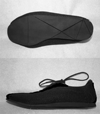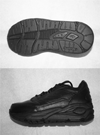Effects of specialized footwear on joint loads in osteoarthritis of the knee
- PMID: 18759313
- PMCID: PMC3653288
- DOI: 10.1002/art.24017
Effects of specialized footwear on joint loads in osteoarthritis of the knee
Abstract
Objective: Elevated dynamic joint loads have been associated with the severity and progression of osteoarthritis (OA) of the knee. This study compared the effects of a specialized shoe (the mobility shoe) designed to lower dynamic loads at the knee with self-chosen conventional walking shoes and with a commercially available walking shoe as a control.
Methods: Subjects with knee OA were evaluated in 2 groups. Group A (n = 28) underwent gait analyses with both their self-chosen walking shoes and the mobility shoes. Group B (n = 20) underwent gait analyses with a control shoe and the mobility shoe. Frontal plane knee loads were compared between the different footwear conditions.
Results: Group A demonstrated an 8% reduction in the peak external knee adduction moment with the mobility shoe compared with self-chosen walking shoes (mean +/- SD 49 +/- 0.80 versus 2.71 +/- 0.84 %BW x H; P < 0.05). Group B demonstrated a 12% reduction in the peak external knee adduction moment with the mobility shoe compared with the control shoe (mean +/- SD 2.66 +/- 0.69 versus 3.07 +/- 0.75 %BW x H; P < 0.05).
Conclusion: Specialized footwear can effectively reduce joint loads in subjects with knee OA, compared with self-chosen shoes and control walking shoes. Footwear may represent a therapeutic target for the treatment of knee OA. The types of shoes worn by subjects with knee OA should be evaluated more closely in terms of their effects on the disease.
Figures
References
-
- Shakoor N, Hurwitz DE, Block JA, Shott S, Case JP. Asymmetric knee loading in advanced unilateral hip osteoarthritis. Arthritis Rheum. 2003;48:1556–1561. - PubMed
-
- Shakoor N, Block JA. Walking barefoot decreases loading on the lower extremity joints in knee osteoarthritis. Arthritis Rheum. 2006;54:2923–2927. - PubMed
-
- Kerrigan DC, Lelas JL, Goggins J, Merriman GJ, Kaplan RJ, Felson DT. Effectiveness of a lateral-wedge insole on knee varus torque in patients with knee osteoarthritis. Arch Phys Med Rehabil. 2002;83:889–893. - PubMed
-
- Kerrigan DC, Johansson JL, Bryant MG, Boxer JA, Croce UD, Riley PO. Moderate-heeled shoes and knee joint torques relevant to the development and progression of knee osteoarthritis. Arch Phys Med Rehabil. 2005;86:871–875. - PubMed
-
- Kuroyanagi Y, Nagura T, Matsumoto H, Otani T, Suda Y, Nakamura T, et al. The lateral wedged insole with subtalar strapping significantly reduces dynamic knee load in the medial compartment gait analysis on patients with medial knee osteoarthritis. Osteoarthritis Cartilage. 2007;15:932–936. - PubMed
Publication types
MeSH terms
Grants and funding
LinkOut - more resources
Full Text Sources
Medical



